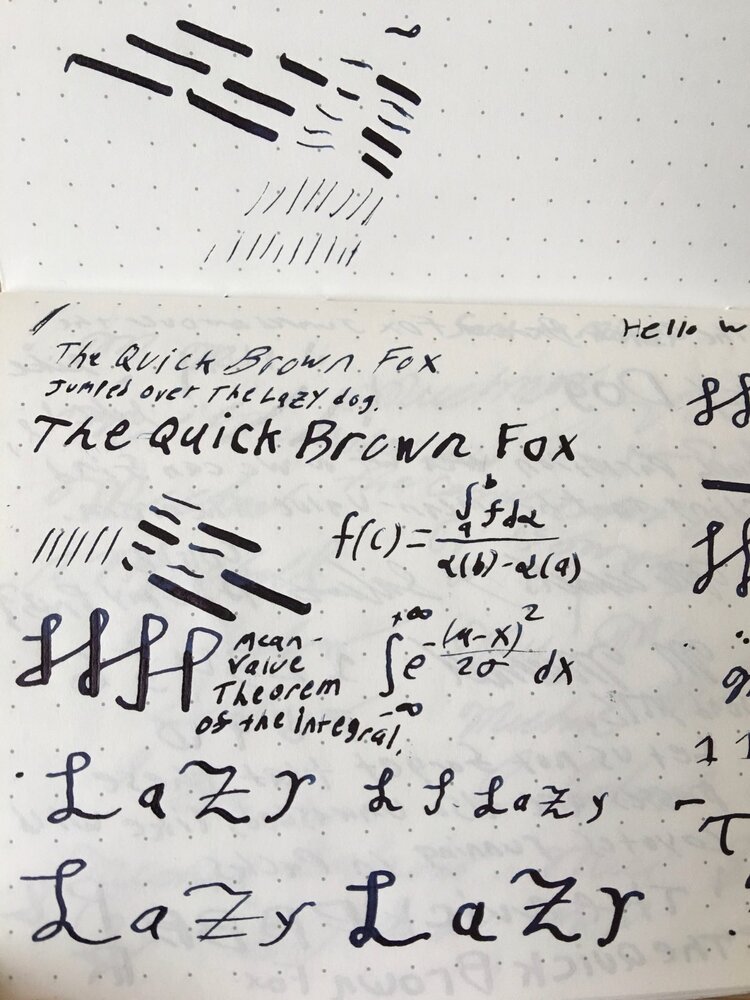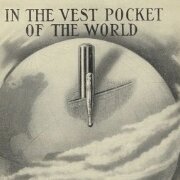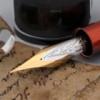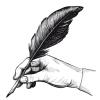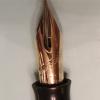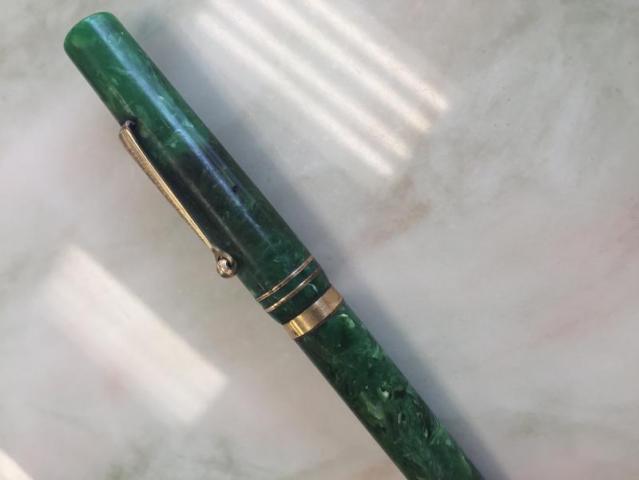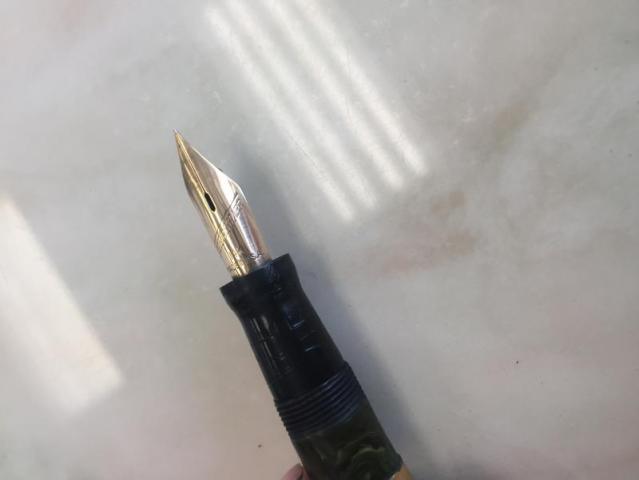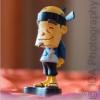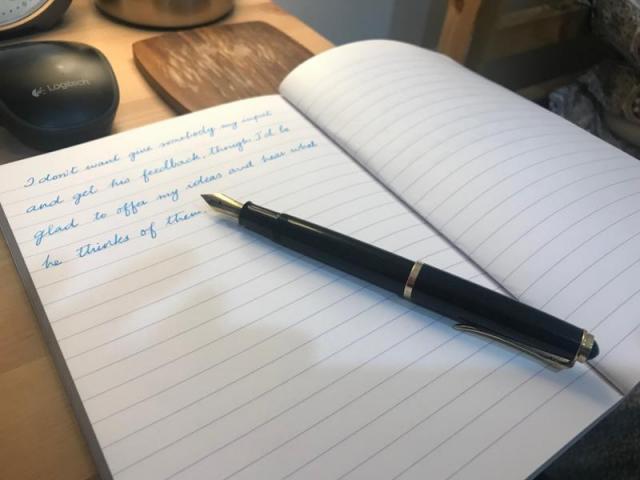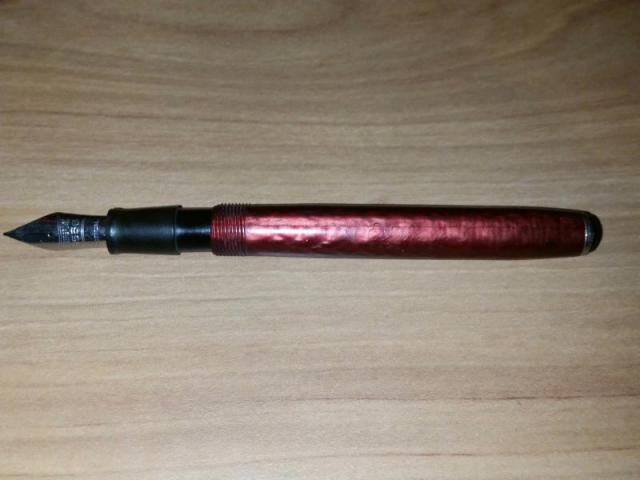Search the Community
Showing results for tags 'restoration'.
-
Polishing products and their compatibility with pen materials
The Honey Batcher posted a topic in Fountain & Dip Pens - First Stop
Hi Everyone Being new in the world of fountain pens and restoration of them, I am not sure how to approach polishing. I know some are in favor of polishing others are not. If you decided to polish what products are best for which material? · Harden rubber · Casein · Bakelite · Celluloid · Thermoplastics · Metal parts · … Assuming that you always start with a less critical area to see how things turn out in the specific case. What products do you recommend for the different materials? I am not looking for long detailed answers. More something simple and short like below. · Harden rubber: XXX, YYY and ZZZ · Casein: XXX and never ZZZ · Bakelite: BBB and YYY · Celluloid: No idea · Thermoplastics: XXX · Metal parts: AAA Let me know if a post about this already exists. I am looking forward to read your answers. Thanks.- 2 replies
-
- restoration
- polishing
-
(and 3 more)
Tagged with:
-
I have recently become somewhat of a vintage flex addict, and in particular, ebonite is my kryptonite. In this process, I acquired a Waterman 55, which is by far my favorite pen due to its versatility and smooth nib. It's usable as an everyday pen, but still has the flex when I want it. But my pen had a somewhat dark chocolatey brown color, quite noticable compared to my rich black Conklin 2 next to it. I didn't realize how brown it was until I got the Conklin pen. I've tried soaking it in oxi-clean, soaking it in ammonia, soaking it with mineral oil, and lightly polishing it. I don't want to polish it too hard, because it does still have some chasing left, and I like the Waterman imprint. I keep reading on here of dyes for ebonite, but I can't find any actual examples of such dyes. What are people using to dye old ebonite? I know dying is controversial, so if there's any other way to make my Waterman 55 the nice rich color like my Conklin 2, please share. I'm somewhat new to vintage pens.
- 8 replies
-
- ebonite pen
- waterman
-
(and 2 more)
Tagged with:
-
New to vintage pens, where to begin with getting two vintage resin piston fillers ready to use?
eggyplantz posted a topic in Repair Q&A
Hi all. I'm new here and looking for a little guidance on best practices to get two new (to me) vintage piston filler fountain pens up to snuff and ready to use. I've attached a couple of photos of the two lovely pens. I purchased them from a seller in the Netherlands and I understand that they are unused or barely used from an old stationery business, and their excellent condition would seem to confirm this. The resin is in great shape and both have tight fitting caps and piston knobs. The integral piston mechanisms both work fairly smoothly and the nibs are beautifully springy, not scratchy, and don't appear to be bent at all. I'm curious how I should proceed to get them ready to write? I'm not clear on the age but based on the styling I would assume mid-century, so I would guess the gaskets and sealants ideally need to be replaced or at least examined. I've never worked on a pen of this age so I'm wondering what your suggestions would be for disassembly in order not to break anything. Some facts about the pens below: Blue "City-Gold": This one's piston can be seen through the ink window portion of the barrel. In the photo attached, I positioned the piston almost to its lowest point. It looks to be a solid rubber plug attached to the piston rod. The end cap is the twisting lever and doesn't come off. Checkered "Royce": This one has a removable piston cap that reveals the twist knob. I can't quite see the piston but the lines between the checkered sections are mostly transparent, so I can see it moving in there and the knob twists freely. Any advice would be much welcomed, or if there are past posts that address this please do direct me there. I did a cursory search but nothing came up that seemed suited to my pens. I have experience with using and light tuning of modern fountain pens but this is my first foray into vintage pens. Thank you!- 1 reply
-
- vintage
- piston fill
-
(and 1 more)
Tagged with:
-
Does anybody know any reputable Indian repairmen who could restore old cellouloid fountain pens ? I have a few old Plato pens in decent condition, i.e. no cracks or dents, but their bodies could do with a little polishing since 50 year old pens have lots of tiny scratches. Please share your experience if you have availed the services of any repairperson in the past.
- 2 replies
-
- restoration
- vintage
-
(and 2 more)
Tagged with:
-
Disclaimer: I am new to vintage fountain pens. I recently acquired a Mabie Todd Swan (photos of the pen and some scribbles below) and would appreciate assistance with the following items: I know very little about this pen and would like to learn about its provenance, approximate age, model and comparison with other Swan models, etc. The body of the pen is marked "Eternal" but the nib is not. Does this mean that the current nib replaced the original? The pen is a very nice writer once the ink is flowing; it can feel very smooth, provides nice line-width variation as the nib is flexible and I think stub-ish, and it lays down a lot of ink. At the same time, it's prone to hard starts and occasionally skips. It also looks like the feed might not be properly aligned with the nib. I would like to have the nib examined and tuned by a professional and was thinking of sending it to Mike Masuyama. Does this seem appropriate, or are there other nib experts I should consider? I would like to have the body of the pen cleaned up and restored prior to getting the nib worked on, but I have no idea who to send it to. Any recommendations? In particular, I would like to have some luster restored to the body, have the fins of the feed looked at as they seem to have some minor damage, and have it cleaned up (the pen has a bit of a smell which, although gradually dissipating, remains pretty strong inside the cap). The tip of the nib looks a bit slanted to me. I know only so much is possible with photos, but can anyone tell if it's because this nib has an oblique grind or if it's some sort of alignment issue?
- 11 replies
-
- vintage
- restoration
- (and 4 more)
-
I recently started restoration on a Waterman's 52 in a nice cardinal red, but I have run into a problem I have never faced before. The nib and feed will NOT budge. I was able to remove the section just fine but the nib and feed have not moved a millimeter from my efforts. I have tried heat and grippers to remove by hand and I even used more heat than I am normally comfortable using to remove a nib and feed and it did not budge. I then moved over to my knock out block, I again used an excessive amount of force to knock the nib and feed and it still would not budge. I then tried dripping some mineral oil into the section with a syringe and let it sit for a few hours in an attempt to either lubricate the section or loosen some dried ink, then tried knocking again, still not even budging. I am running out of options here.... Obviously I wouldn't soak the section in plain water but could I try an ammonia solution without damaging the hard rubber? Any info or suggestions help, take care everyone.
-
Hello All: I am new to the fountain pen world, and have quickly ramped up my collection over the last year. I began with new pens, then discovered the joys (and sorrows) of vintage pen collecting. I've gotten some amazing deals and have been quite happy with my progress. I particularly love my numerous Esterbrooks with various nibs, a lovely little Arnold, Parkette, and several Sheaffer Lifetime Balance pens (all lever filled). As you can see, I don't have super high end pens, nor am I likely to, as I am on a budget. And then...I purchased some amazing pens, for great prices, but I think they will need restoring. All of these pens come from a collection that hasn't been cleaned since the 1990's. I assume they'll need work. But I am guessing the first step is to fill them with water to see if they leak? I've been afraid to touch them. They all LOOK amazing, no scratches that I can see. Someone loved them, collected them, and cared for them, before passing away in 2000 I don't know the first thing about restoration! I could use some help here. What do I need to buy, what's the best way to go about it all? Here are the pens I have purchased that likely need restoring (as well as the price I paid, which, as an aside, I'd like to know how well I may have done). All of the pens apparently "thread okay" Parker 51 ($50) Esterbrook Dollar pen with a 2048 nib ($41) Sheaffer Lifetime 51/2" black barrel with silver cap, gold trim, I think it's a piston filler system? ($79) Vintage Orienta German Matching nib ($14.50) I can include photos if it's helpful. But I wanted to get started with the conversation. Thanks to everyone in advance for the help.
- 1 reply
-
- restoration
- advice
-
(and 5 more)
Tagged with:
-

Conway Stewart Needs Complete Restoration. Who To Send To?
kealani posted a topic in Fountain & Dip Pens - First Stop
I have a Conway Stewart in excellent outside condition. I sent it to a pen repair person for a complete restoration, new sac, nib tuned and polished. I got it back and all it got was "grease" and does not fill or write. Charge was $17. (restoration quote was $40) Rather than pursue with this fellow and waste my time, are there any reputable pen restorers, repair persons in the USA, with an online website, that I can send my pen to for restoration and nib tuning and polish? Thanks for your help. jim -
I came across this pen that probably belonged to my grandfather. First of all I haven't been able to identify the pen or its age. It has a vacumatic fill and an ebonite feed. The ribbed section also seems to be made of ebonite and has some signs of whitening. The biggest problem with this pen is that the barrel has been sloppily glued to the section by some sort of adhesive, most probably many years after the pen was manufactured. The adhesive was quite brittle so I managed to carefully peel it off. What remains behind looks like damage to the barrel itself. The adhesive has dug small pits in the barrel material (maybe celluloid? Bakelite? I'd love to hear your thoughts). Even after the removal of the glue, I can't unscrew the barrel from the section and I'm too scared to force it. I'd really like to know what the pen is made of, how to restore whitening on hard rubber, what parts is the pen made of (threadded, glued) and how one would go about restoring it. I'd really appreciate your input on this pen as I'd be quite interested of restoring it myself.
- 5 replies
-
- sheaffer
- restoration
-
(and 1 more)
Tagged with:
-
Hello Members, I'm currently restoring my grandfather's Parker 51 with a 12K gold cap. The process been surprisingly smooth so far, thanks to YouTube and good luck probably, except I noticed that the nib of the pen doesn't seem quite right. It's a 14k nib and the tip is bent towards the right a bit. I don't have much experience with these pens and I'm wondering if anyone has any ideas about what options I have to remedy this problem. Would I have to purchase a new nib? If so, where can I find one? Could the nib be repaired? Any recommendations of who would be up to the task? I'd appreciate any help in the matter. Thank you kindly! Sincerely, ALA
- 31 replies
-
- parker 51
- restoration
-
(and 1 more)
Tagged with:
-
Hi all, I have 3 vintage Sheaffer fountain pens that were recently passed down to me from my late great-grandfather. I know that one of them is for sure a Sheaffer Snorkel, but I'm not sure about the other two. Images of the Snorkel: https://imgur.com/a/TWdURQp Images of the brown pen: https://imgur.com/a/BYhi5jT Images of the green pen: https://imgur.com/a/2myBKsk The two unknown pens I'm fairly confident I can easily restore. They both AFAIK have petrified sacs, though one of them came apart and I was able to get it out. The Snorkel I am less confident about, given its complexity. I'm somewhat sure that the filling mechanism works (I just accidentally sprayed my dress pants with Waterman Intense Black testing the nib and the pump), but getting the seals and especially the sac replaced will be a doozy. Any comments or thoughts as to what those two pens are or how I should proceed in the restoration process? Thanks!!
- 9 replies
-
- sheaffer snorkel
- sheaffer
-
(and 3 more)
Tagged with:
-
What I do when my wife looks for plant racks for the garden in antique stores is ask to see pens, and its rarely rewarding. This time is was exciting. A sad looking pen, but the blunt rounded shape called for a closer look. Nib looked to have been polished many times, and I could only see K, (I really need to find time for cataract surgery). I have only modern Pels, but Ive seen 100s online. At home, I can read the nib with my loupe, and look at webpages, and its definitely an 100. Looks too delicate to do more than remove the cap. Now Its residing in a tray, and I refrain from touching it. Again, time, prevents a photo. I promise to take a photo when I send it off to rehab. Just read http://www.caprafico.com/pens-88/pelikan-pen-restoration-275 and Im enen more afraid of touching it. Any suggestions?
- 6 replies
-
- pelican 100
- restoration
-
(and 1 more)
Tagged with:
-
I am trying to rescue an estate-sale Sheaffer and am a little puzzled about what I'm finding. My main reference is the material at http://t.richardspens.com/ref/anatomy/vacfil.htm. This is my first Sheaffer teardown, so novice confusion is a possibility and I won't be insulted to be told I've misunderstood something. I'm going to try to make it clear what I've done. It looks to be a black Heritage Autograph Lifetime Balance with a vacuum filler. It has a clip ball with a flat top, a big "LIFETIME" conventional nib (with serial number) and feed, and an engraved signature on the 14K cap ring that matches the family name of the estate. The blind cap turned stiffly, and then came off, leaving a threaded stainless plunger rod sticking out, unmoved from the fully-down position. I see no hint of a brass rod-end or an aluminum lock nut, so it appears this pen had the plunger screwed directly into a threaded hole in the blind cap, as in the pictures on the page above. I presume the plastic female threads in the cap are now stripped; I'm not too worried about that. The rod does not move at all, though. I soaked the pen for a while with the blind cap off. I think I did get a little water into the barrel (probably through the feed) during this soaking; I can see liquid moving around in the barrel through the view striations, and it doesn't seem thick or dark enough to just be old ink. The nib was slightly misaligned sideways on the feed, but I was easily able to shift it back to center with gentle finger pressure. I got it to write nicely with the resulting ink reconstituted from what had dried in the feed and section. I tried just pulling the nib and feed out with my fingers, without success. No surprise. After a 24-hour soak in water with a little detergent in it, the nib and feed seemed reasonably clean, but the rod still wouldn't budge. I tried both pulling on the rod end with my fingers (not much force available there) and clamping it between wood blocks in a vise and pulling moderately on the barrel, in both cases trying to extend the rod as though starting to fill the pen. I didn't want to try too hard. Neither effort produced any motion at all. I warmed the section and lower barrel with a hair dryer, trying the section for motion every minute or so. After maybe five minutes of warming, it gave, and then smoothly unscrewed with modest torque. Nothing seemed amiss; the threads are in good shape (both section and barrel), and there was no sudden snapping, no indication of anything breaking, and no loose plastic bits. The face of the plunger looks as I expect: a conical plastic piece, not quite protruding from the end of the barrel. After a few hours of soaking, I'm still unable to persuade the plunger to move out of the barrel by pressing the back of the plunger rod down against a hardwood block. I am unable to move the conical cap nut even slightly sideways when I push at it with a nail set. When I poke at the rubber gasket with a pin, it has a little give, so I don't think it's completely hard. I suspect that the plunger is stuck because the hard conical backing washer is glued with old dried ink to the inside of the barrel right at the shoulder where the barrel ID changes. (If it was stuck only at the rear packing, I would be able to push the cone sideways at the section end.) I have not resorted to any other sort of press to push it harder; I'd rather try soaking that old ink for longer. Here's the main mystery: I expected to see a "center feed" piece, intended to deflect the plunger cap nut sideways, sticking out of the rear of the section. That's what appears in pictures 1, 4, 5, and 6 at http://t.richardspens.com/ref/anatomy/vacfil.htm. But I see no such thing. Looking into the section from the rear, I see a moderately complicated geometry, but no protruding piece; it's all basically concave. As far as I can tell the conical cap nut (plunger head) wouldn't be touching anything from the section at all. I also don't see a deep hole that a narrow center feed would have slipped into. Is it possible I could have broken that center feed off without knowing it? Did Sheaffer make a version with a conical plunger cap nut but no deflecting protrusion from the feed? Is it likely somebody has replaced the feed with a different one, or broken that bit and reassembled the pen without fixing it? Might I have misidentified the pen altogether? I'm happy to hear advice about getting the plunger unstuck, but I would even more appreciate suggestions about why the section doesn't look as expected. Thanks, George.
- 2 replies
-
- balance
- restoration
-
(and 1 more)
Tagged with:
-

Can I Use Any "sheaffer Touchdown" Restoration Video As A Guide For A Sheaffer Tuckaway?
PotatoJesus posted a topic in Sheaffer
As the title says I am trying to restore an old sheaffer tuckaway but I am having trouble finding restoration guides specifically for it and instead find videos for restoring sheaffer touchdowns that to my knowledge have the same mechanisms it used in the tuckaway. If anyone has a more specific guide that would be very helpful as this would be my first attempt at a restoration. Also, when watching this video there is an o ring that needs to be placed in the Sheaffer Imperial but i am having trouble finding a notch for one....also what size o ring should i look for/ where is the best place to buy one? Any guidance would be greatly appreciated! Okay last minute edit, so I see that anderson pens sells o rings a large and small, but which size should I get?- 15 replies
-
- restoration
- tuckaway
-
(and 1 more)
Tagged with:
-
I just got a Waterman 452 1/2V from Ebay. It was described as being in "excellent condition". Upon arrival it got a basic cleaning. Pulling the fill lever, it was clear that the sack was either dust, or entirely missing. I just happened to have some number 16 sacs sitting around here (slated for a Lady Patricia restore). And they looked about the right size for this pen. My guess was not entirely correct, but the work-around was easy enough. With a #16 sac, it fit over the section well enough, but coaxing it down into the pen itself proved problematic, as it wanted to fold more than feed. The plate which compresses the sac takes up just enough space in the barrel that it was difficult to get the sac into the tube. It occurred to me that if I could make the Sac more rigid, inserting it would not be a problem. Some crazy ideas were considered, such as filling the sac with water, letting it freeze to provide rigidity, but that idea was discarded. The most simple approach looked to be removing the Nib and Feed, and then sliding a Q-Tip down the hole to the bottom of the sac, which would provide the rigidity I needed. I had worked with other pens that either required you use special tools to remove the nib and feed, or you needed to unscrew them. I was at a bit of loss to guess if there was any nefarious traps awaiting me in the nib and feed removal process. Moreover, I could find no videos for the specific model of pen, but there were standard 52 videos, which gave a few hints. Postings within this forum gave a few more hints. The darn thing just presses in place, no special tools or indexing required. With a bit of cold water ran through it, and some gentle persuasion the nib came free first, the feed required some gentle tapping (using a Q-Tip as a drift). At this point, the sac which had just been fitted in place, but not yet had been bonded with shellac was affixed in place with shellac. Now the pen must rest all akimbo throughout the night to allow for curing of the shellac. Tomorrow evening it will get its final assembly, and a bit of tuning (if needed) for the nib/feed. The nib seems to have a generous amount of flex, so I am looking forward to seeing how it writes. Some of those old number 2 nibs make surprisingly good flex pens. The pictures below are of the advertisement on Ebay, the other picture is of the disassembled pen. When it is assembled and writing, there will likely be a follow-up.
- 4 replies
-
- 452 1/2v
- restoration
-
(and 1 more)
Tagged with:
-
I bought this pen on eBay recently and thought I'd stumbled on a wet noodle pen (seller had this in all caps in the title) for a steal at ~$62. Problem is, this pen is almost certainly not a wet noodle, as defined by going off of what I know of them, based on me trying to flex the tines. There's a fair amount of scratching, damage, and bite marks to it, which brings me to my next point. The section and barrel won't come apart, and the lever filler clip stops at a certain point. As someone who is totally inexperienced with restoration, could I restore it on my own or would it be better to send it off to an expert? I could deal with the latter, but as a student, if it costs too much, I don't know if I can. https://www.fountainpennetwork.com/forum/uploads/imgs/fpn_1555954263__img_e4474.jpg
-
Steps To Restore A Vintage Wahl-Eversharp For A Complete Newbie?
hu-327 posted a topic in Repair Q&A
I bought this pen on eBay recently and thought I'd stumbled on a wet noodle pen (seller had this in all caps in the title) for a steal at ~$62. Problem is, this pen is almost certainly not a wet noodle, as defined by going off of what I know of them, based on me trying to flex the tines (which are about as flexible as an Ahab (so not very flexible at all), and much sharper, for those wondering). There's a fair amount of scratching, damage, and bite marks to it, which brings me to my next point. The section and barrel won't come apart, and the lever filler clip stops at a certain point. As someone who is totally inexperienced with restoration, could I restore it on my own or would it be better to send it off to an expert? I could deal with the latter, but as a student, if it costs too much, I don't know if I can. https://www.fountainpennetwork.com/forum/uploads/imgs/fpn_1555954263__img_e4474.jpg -
I bought this pen on eBay recently and thought I'd stumbled on a wet noodle pen (seller had this in all caps in the title) for a steal at ~$62. Problem is, this pen is almost certainly not a wet noodle, as defined by going off of what I know of them, based on me trying to flex the tines. There's a fair amount of scratching, damage, and bite marks to it, which brings me to my next point. The section and barrel won't come apart, and the lever filler clip stops at a certain point. As someone who is totally inexperienced with restoration, could I restore it on my own or would it be better to send it off to an expert? I could deal with the latter, but as a student, if it costs too much, I don't know if I can. https://www.fountainpennetwork.com/forum/uploads/imgs/fpn_1555954263__img_e4474.jpg
-
How To Score Vintage/discarded/nos Pens From Stores In India?
AnuragTukan posted a topic in India & Subcontinent (Asia)
Hi everyone, As a fountain pen collection and restoration enthusiast it has been very hard in my city to come across more affordable pens, after exhausting the selection of easily available ones (I have a tight budget as I am a student) However, a few days back I went to a stationary shop for some work and say that they had some old chelpark inks on display (ofcourse I bought all of them), curiously I asked the man if he had fountain pens, he told me that he had many old unsold ones and didn't know where they were, after a lot of persuation he agreed to look for them and have them ready in a few days. So the next day I went and he said he didn't find them and to come back a few days later. So I did, again and again. (was pretty desperate to get a hold of some childhood oens) Fortunately, after a week or so, he finally had them ready. They were not exactly vintage, but old pens indeed, some quite damaged. I got a few Camlin No. 6 pens, some Flora Pens (the model number is not known) and a couple Hero 323. All of them were more or less usable atleast after some repairs. This brings me to my question, if this man had old stocks, probably other shops do too, and it would be great to have a few tips on how I can get these shops to sell me their old stocks, even if they're broken or damaged, how do I persuade them to dig them out for me, because every other shops I've asked, have said 'no we don't have fountain pens" to my face. Btw I'm new to FPN (this is my first thread) Regards, Anurag.- 10 replies
-
- vintage pens
- indian pens
-
(and 6 more)
Tagged with:
-
I received a very beautiful, if broken, vintage button filler some time ago and started working on it last week. It needs a new sac and this I can handle, but the pressure bar is quite rough and a little rusted in some places. This is my first repair so I'm not quite sure what I can and can't do. Should I replace the bar? I can't find a right size replacement (7 cm) anywhere so I'm thinking of just using this old one. The bar is not snapped or cracked and it's still very springy.
- 9 replies
-
- pressure bar
- repair
-
(and 3 more)
Tagged with:
-
Hey all, I bought an M200, and was poking around what was left of my searches online. I found a barrel with working piston on eBay for an M150 ($35). Now I know the nibs can be found in loads of places probably for another $30. But, I didn't even think about the cap. Would it be difficult to find a cap for a Pelikan M150, or is it compatible with the caps for other Pelikans? Does it become financially unreasonable to get the 3 pieces separately? I thought it'd be a nice project to add to over time.
-
I always wondered, about the reasons which made Pelikan pens so famous. Although, I have to admit I never used any Pelikan pen before. A few days ago, I saw an ad for an old Pelikan pen in the second-hand marketplace, so I took a gamble and purchased this Pelikan 400NN. It was a remote transactionss so I was not sure what was the condition of the pen. Images did not show any significant damage. I bought this pen for 70USD. Today I received the pen and as expected piston was almost jammed. With extra care, I could turn it. But luck was on my side, and when I tried to unscrew the nib section, the section opened without any resistence. The pen was clean. I flushed it with clear water. I applied silicone grease on the piston and piston started to move like new. After assembling it back, I filled it with Waterman Inspired Blue. The pen writes beautifully. Now I understand why some people were crazy about these vintage nibs. The nib is smooth, and with a flex, I have not experienced with any other pen. This is not a review just sharing my experience with my first Pelikan although a vintage. Below are some of the images. Hey! I forgot the important part. The pen came in original box with matching Mechanical Pencil and Ballpoint.
-
I just recently found (as in actually found, more on this later) an Esterbrook pen in surprisingly nice condition. The only issue is that it was missing the cap, but the nib, section, and barrel were all there and in mostly working condition. I decided I wanted to restore it as it's my first lever filler, and have since removed the old sac and fully cleaned its remnants. All that's left is waiting for parts to arrive. From what I can tell, the pen appears to be an Esterbrook dollar pen (*actually most likely a J series, as pajaro pointed out), but without the cap it's difficult to tell. It's also difficult to tell if it's red or copper in colour -- in person, it looks too dark to be copper, but also too dark to be red. The attached pictures make it look noticeably more red than it is in person. I'm also curious where the best locations to buy parts are. I've of course tried ebay, but I haven't seen just a cap yet. On a few of the other sites I've googled, just trying to buy a cap runs you more than the whole pen without even factoring in shipping. I was wondering if there are a few recommended sites or people to buy parts from at a reasonable price? Link to album with pictures: https://imgur.com/a/c6bCn (The pen itself, see linked album for more pictures) As for the "more info", I actually found it during a daily walk around the park. It was just lying in the grass without a cap in a location that's seldom traveled. The sac was completely useless, and definitely hasn't been recently restored. I spent a couple hours looking for the cap but wasn't able to find it, assuming it was even with the pen. The area I live in likely doesn't have many fountain pen users either, and it was obviously not there long -- the whole situation is definitely mysterious.
- 8 replies
-
- esterbrook
- parts
-
(and 1 more)
Tagged with:
-
Hello, Would anyone have any tips on removing the section from a Sheaffer Junior 275? I have tried soaking the pen, applying heat, and using section pliers, but the section just won't budge for me. Please see pics for reference. I currently have the nib and feed removed for cleaning since I couldn't get the section off to replace the sac.
- 4 replies
-
- sheaffer
- restoration
-
(and 2 more)
Tagged with:
-
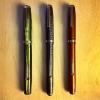
Sheaffer Vac-Fill Packing Unit Knock-Out: An Alternative Restoration Method?
spaceink posted a topic in Repair Q&A
Hello, I've recently repaired a few Sheaffer vac-fillers using the method I often see in these parts of drilling through the barrel to the packing unit and picking out the rubber and felt. I then came across this method by Grandmia, in which he says that he soaked and heated the barrel, before using a dowel to knock out the packing unit for repair. I'm keenly interested in this method, what with the difficulty of alternatively picking out the packing unit through the barrel. Has anyone else tried this? Approximately how long does the barrel need to be soaked? (I've been soaking for three days and the packing unit is not budging at all). Video by Grandmia: Any thoughts would be appreciated.







